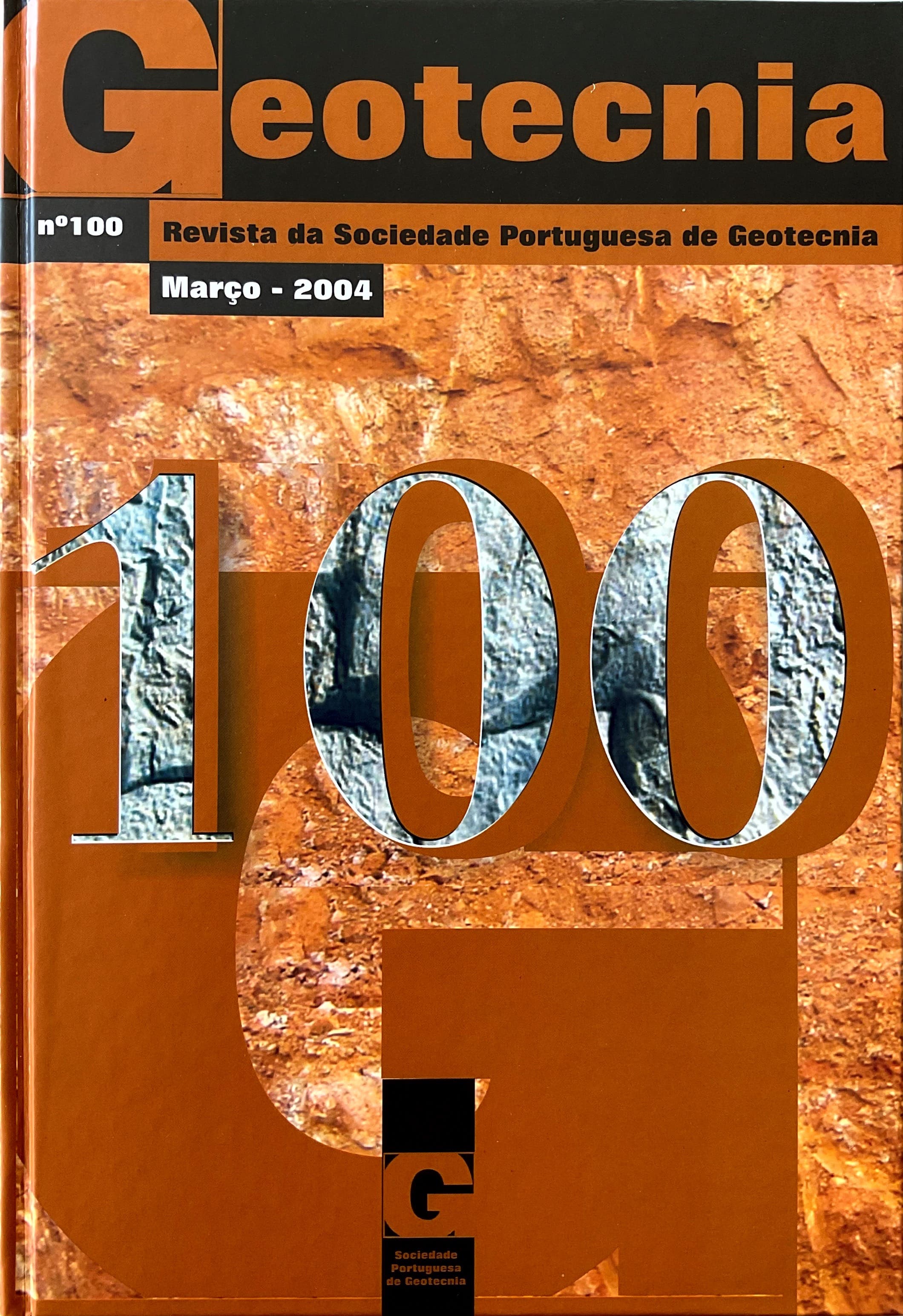Slopes instabilised by percolation, and visceral correction of current analysis and significant stabilising drains
DOI:
https://doi.org/10.14195/2184-8394_100_6Keywords:
Análises, Estabilidade, Taludes, Barragens, Correcções, Resistência, DeformaçõesAbstract
Mentioning in passing Nature's complex factors of dominant hazards and risks, erratic, much less predictable than those of soil structures built under control, one recalls the basic principle of solving challenges by change of "physical universe" to a less vulnerable one, amenable to the statistics of averages. It is exemplified with an earth dam (de Mello, 1977; Viotti, 1989). Moving to conventional analyses of slope destabilizations, one demonstrates that historic and regional coincidences (Bishop, 1952) introduced a "polluting gene" into all the methods and computer programs in use. Generated by a simplifying assumption of Terzaghi (1936) the calculations persist along 67 years with an appreciable error, conceptual and numerical, obviously conservative, uneconomical. One senses a predominant seduction of computation, diverting the civil-geotechnicians from enthusiasms towards the exhilaration of progressive advancement of geotechnique's really controllable factors. One submits proposed conceptual and practical corrections, founded on the questful advances, and on convinced and convincing querying of the primordial steps, inevitably cruder, of parameters and hypotheses gratefully recognized as having served the profession for a long time. Examples are presented of some of the errors, amenable to prompt corrections.
Downloads
References
Arêas, O. M. (1963). Piezômetros em Três Marias. II CPMSEF, ABMS, pp. 413-440.
Asce-Geoinstitute. (2000). Slope stability 2000. Edited by Griffiths, D. V. et al.
Bear, J. et al. (1968) Physical principles of water percolation and seepage, UNESCO, Arid zone research.
Bishop, A. W. (1952). Stability of Earth Dams. London Univ., Ph.D. Thesis.
Bishop, A. W. (1955). Use of the slip circle in stability analysis of slopes . I Tee. Sess.: Gen. Theory of Stability of Slopes, Géotechnique, vol. 5, n°. 1, pp. 7-17.
Bishop, A. W. (1966). The strength of soils as engineering materials". Rankine Lecture, Géotechnique, vol. 16, n°. 2, pp. 91-126.
Bishop, A. W. (1971). Shear strength parameters for undisturbed and remoulded soil specimens. Proc. Roscoe Memorial Symposium, Cambridge Univ., pp. 3-58.
Bishop, A. W. e Bjerrum, L. (1960). Relevance of the triaxial test to the stability problems. Conf. on shear strength of cohesive soils, Colorado, ASCE, pp. 437-501.
Bjerrum, L. et al. (1958). The effect of time on the shear strength of a soft marine clay. Brussels ECSMFE, vol. 1, pp. 148-158.
Bouwer, H. (1963). (summary) Appendix E, limitations of Dupuit-Forchheimer assumption in recharge and drainage. Symp. on transient ground water hydraulics, pp. 201-211.
de Mello, V. F. B. (1975). Lessons from unsuspected, real and fictitious problems in earth dams in Brazil. VI African CSMFE, Durban, vol. 2, pp. 285-304.
de Mello, V.F.B. (1977). "Reflections on design decisions of practical significance to embankment dams". Rankine, Géotechnique, vol. 27, n° 3, pp. 279-355.
de Mello, V. F. B. (1981). Facing old and new challenges in soil engineering. M.I.T. Past, Present and Future of Geotechnical Engineering, M.I.T, pp. 160-204.
de Mello, V. F. B. (1984). Closing remarks. IV Intern. Symp. on Landslides, Toronto, vol. 3, pp. 147-150.
de Mello, V. F. B. et al. (2003). Opening renewed and continually renewing vistas for geotechnique through widespread diffusion of simplest Statistics-Probabilities (SP) with nominal Confidence Intervals, (Cl)". Intern. e-Conf. on modem trends in Found. Eng'g, Madras, India, in press.
de Mello, V. F. B. et al. (2004a). Reappraising historical coincidences that radically misled slope destabilization analyses of homogeneous earth dams. Skempton Memorial Conference, London, in press.
de Mello, V. F. B. et al. (2004b). Landslides by maximized infiltration: fundamental revision of stability calculations and stabilizing drainages. IX Intern. Symp. on Landslides, Rio de Janeiro, in press.
Forrester, K. (2001). Subsurface drainage for slope stabilization. ASCE Press.
Gould, J. P. (1959). Construction for pressures observed in rolled earth dam. Tech. Mem. 650, U.S. Bureau of Reclamation, Denver - Colorado.
Impregilo (Impresit Girola Logidiani) (1982) Twenty-five years of worldwide activity, 1956/1981, pp. 88-109.
Janbu, N. (1980). Critical evaluation of the approaches to stability analysis of landslides and other mass movements. Intern. Symp. on Landslides, New Delhi, Sarita Prakashan, vol. 2, pp. 109-128.
Lowe III, J. (1988). Chpt. 9. Stability analysis in earthfill dam design and analysis, of Advanced dam engineering. Ed. Robert B. Jansen, Van Nostrand Reinhold, pp. 275-285.
Lowe III, J. e Karafiath, L. (1959). Stability of earth dams upon drawdown. l PANAMCSMFE, Mexico, vol. 2, pp. 537-552.
Muskat, M. (1946). The flow of homogeneous fluids through porous media. J. W. Edwards, Inc., Ann Arbor, Mich.
Scott, R. F. (1987). Rankine Lecture Failure. Géotechnique, vol. 37, n° 4, pp. 423-466.
Seed, H.B. e Sultan, H.A. (1967). Stability analyses for a sloping core embankment. Journal ASCE, vol. 93, n° 4, pp. 69-83.
Seely, F. B. e Ensign, N. E. (1941). Analytical mechanics for engineers. John Wiley & Sons.
Spofford, C. M. (1939). The theory of structures. McGraw-Hill Book Co.
Skempton, A. W. (1966). Summing up. ICE-RCA Symposium LARGE BORED PILES, pp. 155-157, (p. 157).
Sultan, H. A e Seed, H. B. (1967). Stability of sloping core earth dams. Journal ASCE, vol. 93, no. 4, pp. 45-47.
Taylor, D. W. (1948). Fundamentals of Soil Mechanics. John Wiley & Sons lnc., New York, pp. 104-204, pp. 406-479.
Terzaghi, K. V. (1936). Critical height and/actor of safety of slopes against sliding, Proc. I ICSMFE, Cambridge, Vol. l, G-6, pp.156-161.
Terzaghi, K. V. (1943). Theoretical Soil Mechanics. Wiley.
Terzaghi, K. V. e Peck, R. B. (1948). Soil Mechanics in Engineering Practice. Wiley: 2nd Ed., (Revised, 1967).
Viotti, C. B. (1989). Emborcação dam: a Rankine lecture design successful performance. de Mello Tribute Volume, Ed. Edgard Blucher Ltd., Sao Paulo, pp. 517-527.
Wright, S.G. et al. (1973). Accuracy of equilibrium slope stability analysis. Journal ASCE, vol. 99, n° 10, pp. 783-791.




